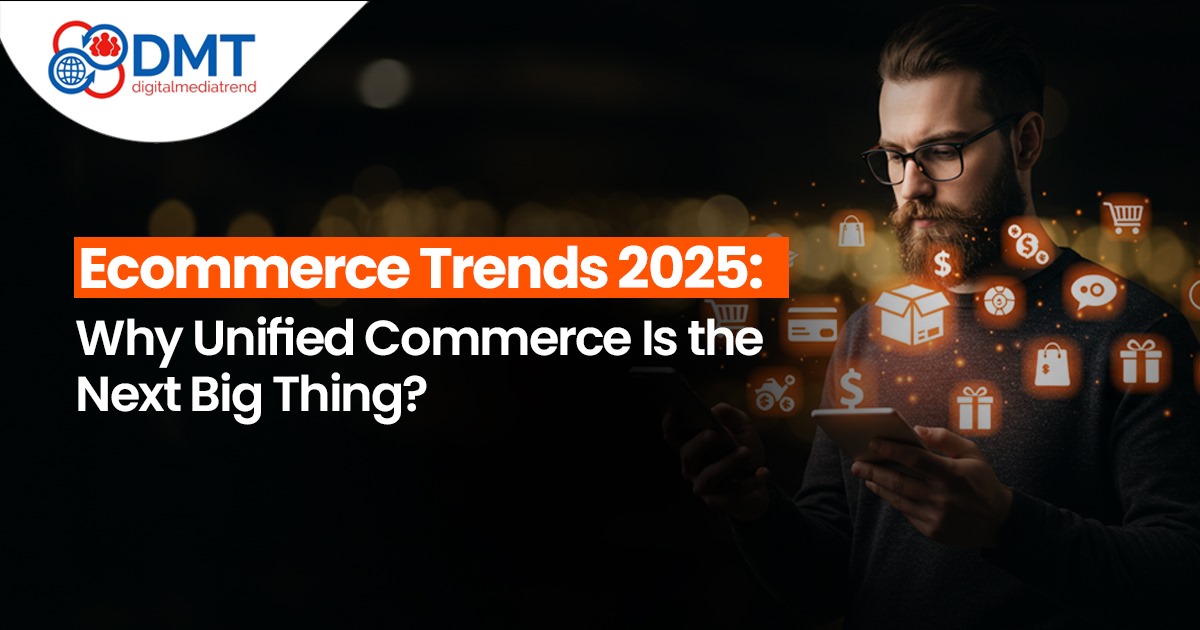In 2025, ecommerce is no longer just about running an online store. It has evolved into a complex ecosystem where customer experiences span across multiple platforms, devices, and channels. From mobile apps to social media shops, from in-store kiosks to AI-powered chatbots, buyers expect everything to connect seamlessly. This is where Unified Commerce steps in as the next big revolution in ecommerce.
For businesses in Lahore, Pakistan and across the globe, adopting unified commerce isn’t just an advantage—it’s becoming a necessity to stay competitive. At DMT Lahore, we help businesses understand and implement advanced digital strategies that align with global ecommerce trends, ensuring sustainable growth.

What Is Unified Commerce?
Unified commerce is the integration of all sales channels, customer touchpoints, and back-end operations into one single platform. Unlike multichannel or omnichannel strategies—where data often remains fragmented—unified commerce creates a centralized hub for all processes.
This means whether a customer shops online, visits a physical store, interacts through a mobile app, or engages on social media, the experience is consistent, real-time, and data-driven.
Key elements of unified commerce include:
- Centralized customer data across all channels.
- Real-time inventory management and product availability.
- Integrated payment systems (online, offline, mobile wallets, BNPL).
- Unified customer service across chat, phone, and in-store interactions.
- Analytics-driven personalization at every touchpoint.
Ecommerce in 2025: The Evolution
The global ecommerce market is expected to surpass $7.5 trillion by 2025, driven by advanced technology adoption and changing customer expectations. In Pakistan, cities like Lahore, Karachi, and Islamabad are witnessing rapid ecommerce adoption thanks to growing internet penetration, improved logistics, and digital payment solutions.
However, the real transformation is happening through data-driven decision-making and cross-channel experiences. Traditional ecommerce businesses that only operate online are being overtaken by those who deliver borderless, consistent shopping journeys—powered by unified commerce.
Why Unified Commerce Is the Next Big Thing
- Customer Experience Is Everything
In 2025, customer expectations are higher than ever. Buyers want seamless shopping experiences whether they are browsing Instagram, visiting a retail outlet in Lahore, or completing checkout via a mobile app. Unified commerce ensures that preferences, purchase history, and loyalty rewards are synced everywhere.
- Real-Time Data Synchronization
Unlike omnichannel ecommerce, unified commerce provides real-time synchronization. If a customer buys the last piece of a product online, the system instantly updates inventory for all channels. This prevents overselling and enhances trust.
- AI and Personalization at Scale
AI-powered unified commerce systems analyze customer data across every touchpoint. This allows hyper-personalization—such as recommending products, sending dynamic pricing offers, or optimizing cart recovery strategies. For example, a customer in Lahore who browses smart home devices online can receive targeted offers when they visit a physical store.
- Efficient Back-End Operations
Unified commerce integrates ERP (Enterprise Resource Planning), CRM (Customer Relationship Management), and POS (Point of Sale) systems into one platform. This reduces inefficiencies, lowers costs, and empowers teams with better decision-making tools.
- Seamless Payments and Logistics
From mobile wallets in Pakistan (Easypaisa, JazzCash) to global BNPL (Buy Now Pay Later) systems, unified commerce supports multiple payment gateways. Similarly, logistics partners are integrated to provide real-time shipment tracking, building customer trust.
- Bridging Online and Offline Retail
For businesses in Lahore’s retail hubs like Gulberg or Liberty Market, unified commerce connects physical outlets with online stores. Customers can browse online, check availability, reserve items, and pick them up in-store—all synchronized in real-time.
Technologies Driving Unified Commerce in 2025
- Cloud-Based Commerce Platforms
Cloud infrastructure provides flexibility, scalability, and global reach. Platforms like Shopify Plus, Magento 2, and custom enterprise systems are integrating unified commerce modules.
- AI & Machine Learning
AI enhances product recommendations, dynamic pricing, fraud detection, and customer support automation. Machine learning continuously improves accuracy based on buyer behavior.
- IoT and Smart Devices
Smart devices like connected refrigerators or voice assistants (Alexa, Google Assistant) are becoming ecommerce touchpoints. Unified commerce integrates these interactions seamlessly.
- AR/VR Shopping
Augmented Reality (AR) and Virtual Reality (VR) allow customers to try products virtually before purchasing. Unified commerce ensures AR experiences are tied back to centralized inventory and customer profiles.
- Blockchain for Transparency
Blockchain secures transactions, verifies product authenticity, and ensures transparency in supply chains—critical for ecommerce businesses selling premium products.
Benefits for Pakistani Businesses
For companies in Lahore and across Pakistan, unified commerce offers clear advantages:
- Faster Growth: Businesses can scale across multiple channels without losing consistency.
- Better Customer Loyalty: Unified rewards and loyalty programs increase retention.
- Operational Efficiency: Reduced duplication and manual errors save time and cost.
- Global Competitiveness: Pakistani ecommerce companies can compete with international brands by offering the same level of seamless experience.
The Future of Ecommerce Belongs to Unified Commerce
By 2025, businesses that fail to adopt unified commerce will struggle with fragmented customer experiences, inefficient operations, and lost opportunities. Whether you’re a startup in Lahore or an established retailer across Pakistan, the time to invest in unified commerce is now.
At DMT Lahore, we believe unified commerce is not just a trend—it’s the foundation of the future of ecommerce.
FAQs
- How is unified commerce different from omnichannel commerce?
Omnichannel focuses on presence across multiple channels, but unified commerce integrates all data and processes into one system, ensuring real-time synchronization. - What technologies are essential for unified commerce in 2025?
AI, cloud platforms, IoT, AR/VR, and blockchain are the key technologies driving unified commerce. - Is unified commerce suitable for small businesses in Lahore?
Yes. Even small retailers can benefit from unified commerce by syncing their POS with ecommerce platforms and offering consistent customer experiences. - How does unified commerce improve customer satisfaction?
It provides seamless, personalized, and real-time experiences across every channel, enhancing trust and loyalty. - Can DMT Lahore help businesses implement unified commerce strategies?
Absolutely. DMT Lahore offers advanced digital marketing and ecommerce solutions tailored to Pakistani businesses, helping them adopt unified commerce for sustainable growth.

